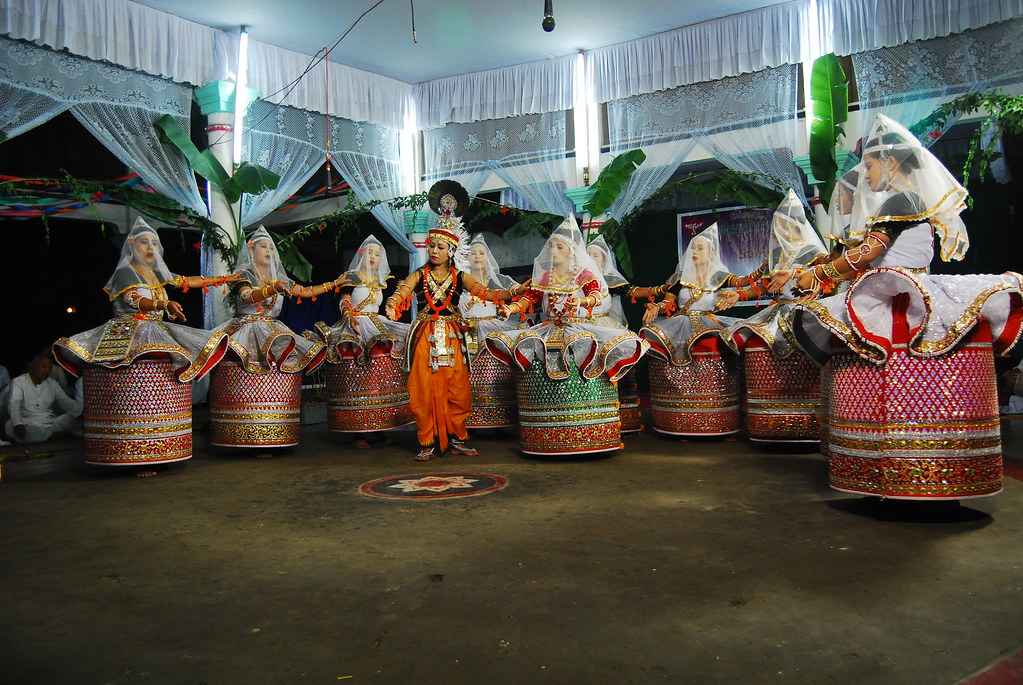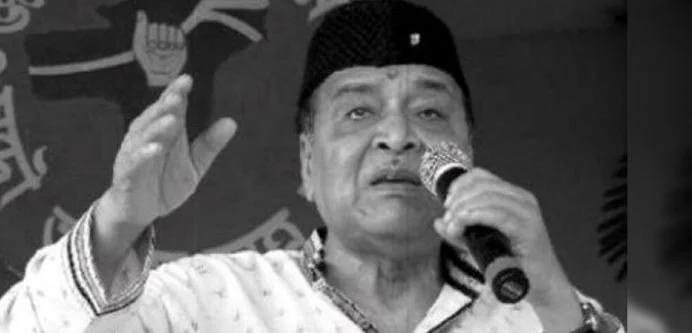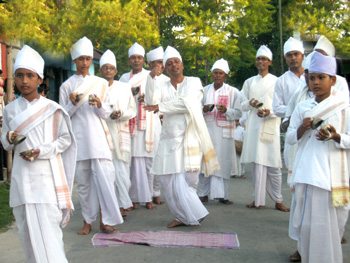Raas Leela, often considered one of the most captivating and spiritually rich narratives in Hindu mythology, delves into the divine love between Lord Krishna and the Gopis (milkmaids) of Vrindavan. It is more than just a dance or a festival; it is a portrayal of divine play (Leela) that represents the love, joy, and harmony between the divine and its devotees. Raas Leela holds deep symbolic and cultural significance, especially in regions such as Vrindavan and Mathura, where it is celebrated with fervor and devotion. This blog will explore the Raas Leela, its roots, significance, interpretations, and its influence on art and culture.
The Origins of Raas Leela
The term “Raas Leela” is derived from the Sanskrit words “Raas,” meaning “dance,” and “Leela,” meaning “play” or “divine play.” Raas Leela is referenced in ancient Hindu scriptures, especially in the Bhagavata Purana, where it is said to have taken place on the banks of the Yamuna river in Vrindavan. According to the scriptures, Lord Krishna, at the age of seven, enchanted the Gopis with his flute, leading them to leave their worldly responsibilities and join him in a mesmerizing dance of love and devotion under the full moon.
The Raas Leela represents the pinnacle of devotion, known as bhakti, where the Gopis transcend the barriers of social norms, familial obligations, and individual egos to immerse themselves in the divine love of Krishna. It is believed that during the Raas Leela, Krishna manifested himself in multiple forms, allowing every Gopi to dance with him, symbolizing the omnipresence of the divine in every heart.
Symbolism and Spiritual Significance of Raas Leela
Raas Leela, Krishna’s divine dance with Radha and the Gopis, is deeply symbolic, transcending a mere love story to express profound spiritual truths. Its layers of meaning depict the soul’s eternal journey toward unity with the divine, making it a cornerstone of spiritual expression in Hindu culture.
Symbol of Divine Love
At its heart, Raas Leela represents a love that is more than worldly affection; it is the yearning of each soul for connection with the Supreme. Krishna, as the divine consciousness, attracts the Gopis (who symbolize devoted souls) towards him, embodying a relationship where pure love seeks no reward but the joy of union with the divine.
Raas Leela as an Allegory
Beyond its narrative charm, Raas Leela conveys a philosophical truth: each soul is on a quest for spiritual completeness. In this allegory, every soul is seen as a “Gopi,” striving for eternal happiness and fulfillment found only in communion with Krishna, or the universal spirit. The dance symbolizes this journey, where worldly desires fade, giving way to a divine connection.
Balance of Bhakti and Rasa
Raas Leela beautifully blends bhakti (devotion) with rasa (aesthetic experience). The performance encapsulates intense devotion while also appealing to the senses, creating an experience where art and spirituality meet. This balance highlights Raas Leela’s unique ability to inspire both deep reverence and joy, making it a powerful cultural expression that continues to captivate devotees and artists alike.
Cultural Celebrations of Raas Leela

In Vrindavan, Mathura, and many parts of India, Raas Leela is celebrated with immense grandeur during festivals such as Janmashtami (Krishna’s birthday) and Sharad Purnima (the full moon night of autumn, which is believed to be the original night of Raas Leela). These celebrations include re-enactments of the dance, usually performed by young artists and devotees who bring Krishna’s divine play to life through dance, music, and drama.
The Raas Leela is not only a part of religious festivities but also an artistic expression that has influenced classical Indian dance forms like Kathak and Manipuri. In Kathak, the “Krishna-Radha” narrative often forms the basis of several dance performances, while in Manipuri dance, the Raas Leela is central to the tradition, with unique costumes, music, and dance movements designed to represent the love of Radha and Krishna.
These performances are deeply devotional and are meant not just for entertainment but for invoking the presence of the divine. The dancers aim to connect with Krishna through their movements, portraying both the joy and the spiritual surrender of the Gopis. Audiences, in turn, experience an emotional and spiritual upliftment, fostering a sense of connection with the divine through art.
The Philosophy of Divine Love
At its heart, Raas Leela is a celebration of divine love that transcends worldly desires and attachments. Krishna’s love for the Gopis is not limited by physical or material desire; instead, it is a pure, spiritual bond that reflects the concept of Prema Bhakti—unconditional love towards God. In this sense, the Gopis’ love for Krishna is a representation of the soul’s longing for union with the divine, a theme common in many mystic traditions around the world.
Many scholars and saints have offered interpretations of Raas Leela, particularly within the Bhakti tradition. For instance, the poet-saint Mirabai saw herself as one of the Gopis, constantly longing for union with Krishna, whom she considered her divine lover. The Raas Leela narrative has inspired countless poets, artists, and musicians, from Jayadeva’s Gita Govinda to modern-day devotional songs and art, all of which emphasize the theme of surrender and divine love.
Artistic Elements in Raas Leela
Raas Leela is not only a spiritual story but a mesmerizing artistic performance, where every movement, color, and note brings out the essence of divine love and devotion. Each artistic component, from gestures to music, deepens the connection with Krishna’s tale, turning it into a heartfelt expression of cultural and spiritual beauty.
Dance Movements and Gestures
The dance in Raas Leela uses precise, graceful movements and gestures, or mudras, to convey emotions like love, devotion, and yearning. Each step and hand movement is thoughtfully choreographed to express the intimate and joyous connection between Krishna and the Gopis, inviting the audience to feel these emotions with every gesture.
Costumes and Colors
Performers in Raas Leela wear vivid costumes that reflect the personalities of Krishna, Radha, and the Gopis. Krishna’s attire, typically in blue, symbolizes his divine nature, while Radha often wears shades of red or yellow, representing love and purity. The colors and costume details enhance each character’s role, creating a visual spectacle that feels both sacred and enchanting.
Music and Lyrics
The music in Raas Leela plays a crucial role in evoking the performance’s spiritual atmosphere. Instruments like the flute, tabla, and harmonium accompany traditional songs and chants, with lyrics that praise Krishna’s beauty and the longing of the Gopis. Each melody is infused with devotion, guiding listeners toward an experience of divine joy and closeness. These musical elements complete the performance, offering both performers and audience a shared journey of the heart and soul.
Contemporary Relevance of Raas Leela
Though rooted in mythology, Raas Leela holds lessons that resonate in today’s world. The celebration of Raas Leela emphasizes unity in diversity, a theme that is particularly relevant in a world where divisiveness often overshadows common humanity. The Raas Leela teaches us to look beyond superficial differences, to recognize the divine spark in every individual, and to strive towards love and understanding.
The Raas Leela is also a reminder of the importance of spirituality and connection with the divine. In a fast-paced, materialistic world, Raas Leela reminds us to seek moments of inner peace, to reconnect with our true selves, and to remember that the ultimate joy lies not in worldly achievements but in the simple, selfless love that unites us with the divine.
Conclusion
Raas Leela is a powerful and timeless portrayal of divine love, unity, and spiritual transcendence. Through the ecstatic dance of Krishna and the Gopis, it reminds us of the eternal, blissful relationship between the soul and the divine. It encourages us to shed our egos, overcome our worldly attachments, and immerse ourselves in the beauty of pure, unconditional love.
Whether viewed as a spiritual allegory, a cultural celebration, or an artistic inspiration, Raas Leela remains a profound narrative that continues to captivate hearts and minds across generations. It serves as a bridge between the earthly and the divine, inviting each of us to join in the eternal dance and experience the joy of unity with the divine.












